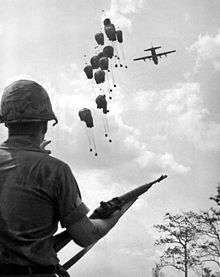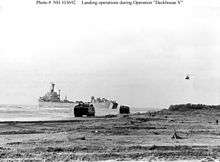1967 in the Vietnam War
| 1967 in the Vietnam War | |||
|---|---|---|---|
 Air drop of supplies in Operation Junction City | |||
| |||
| Belligerents | |||
|
Anti-Communist forces: |
Communist forces: | ||
| Strength | |||
|
South Vietnam ARVN: 798,800 [1] | |||
| Casualties and losses | |||
|
US: 11,153 killed South Vietnam: killed | North Vietnam: 140,000 casualties | ||
January
- January 6, 1967
Operation Deckhouse Five was conducted by the United States Marine Corps and South Vietnamese Marine Corps forces along the Mekong River Delta, as part of the Vietnam War. The operation was notable in that it was a sizable, combined U.S. Marine and Vietnamese Marine amphibious operation and it was the last Special Landing Force (SLF) amphibious landing to take place beyond the boundaries of I Corps. The operation occurred January 6–15, 1967.
- January 8, 1967
Operation Cedar Falls was a military operation conducted primarily by US forces. The aim of this massive search and destroy operation was to eradicate the so-called "Iron Triangle", an area located in close proximity to Saigon which had become a major stronghold of the communist National Liberation Front (NLF) or Viet Cong. The operation began on January 8, 1967 and ended on January 28, 1967.[2]
-

Two U.S. Marine Corps amphibious tractors are moving along the beach in the foreground, with a UH-1 helicopter approaching at right. USS Washtenaw County (LST-1166) is in the background during Operation Deckhouse Five.
February
- February 14, 1967
The Battle of Tra Binh Dong was probably the most famous battle fought by the South Korean Marines. It was fought in the Tra Binh Dong village near the border of Cambodia.
- February 17, 1967
Operation Bribie, or the Battle of Ap My An, was fought during the Vietnam War in Phuoc Tuy province between Australian forces from the 6th Battalion, Royal Australian Regiment (6RAR) and the Viet Cong, reinforced by North Vietnamese regulars.
- February 22, 1967
Operation Junction City was an 82-day military operation conducted by United States and Republic of Vietnam (RVN or South Vietnam) forces begun on February 22, 1967 lasting until May 14, 1967. It was the largest U.S. airborne operation since Operation Market Garden during World War II, the only major airborne operation of the Vietnam War, and one of the largest U.S. operations of the Southeast Asian conflict.[2]
April
- April 21
Operation Union was a military operation conducted by the United States Marine Corps. It was a search and destroy mission in the Que Son Valley carried out by the 1st Marine Regiment. The object of the operation was the 2nd Division of the People’s Army of Vietnam (PAVN, often in US sources "North Vietnamese Army" or NVA). Launched on April 21, 1967 the operation ended May 16.[2]
From April to May 1967 The Hill Fights was a battle between the People's Army of Vietnam (PAVN or NVA) and United States Marines on Hills 881 North, 881 South, and 861 north of Khe Sanh Combat Base in the I Corps Tactical Zone.
May
- May 11, 1967
Running from May 11 to 1 July 1967 Operation Malheur I and Operation Malheur II were a series of military actions conducted by the United States army subduing increased activity by National Liberation Front (NLF) forces in the northern part of South Vietnam.
- May 25, 1967
Operation Union II was a search and destroy mission in the Que Son Valley carried out by the 5th Marine Regiment. Launched on May 25, 1967 the operation ended June 5.[2]
July
- July 2, 1967
Running from July 2 to July 14, 1967 Operation Buffalo was a major operation that took place in the southern half of the DMZ, northeast of Con Thien.[2]
- July 2, 1967
The Battle of July Two was a short engagement that took place along Route 561 between Gia Binh and An Kha, during Operation Buffalo. The North Vietnamese 90th Regiment was engaged with the American Marines.
- July 9, 1967
Operation Hong Kil Dong was the largest South Korean operation of the Vietnam War to halt infiltration into friendly areas.
September
- September 19
The Royal Thai Army Regiment starts its deployment in South Vietnam.[3]
- September 4, 1967
Operation Swift was a search and destroy mission in the Que Son Valley carried out by the 1st Marine Division. Launched on September 4, 1967 the ensuing battles killed 114 Americans and an estimated 376 North Vietnamese. The operation ended September 15.[2]
October
- October 10, 1967
Operation Medina was a search and destroy operation conducted in the Hai Lang Forest Reserve of South Vietnam. It lasted till the 20th of October.
- October 17, 1967
The Battle of Ong Thanh was a battle of the Vietnam War that saw the soldiers of the 2nd Battalion, 28th Infantry (the "Black Lions"), ambushed and subsequently decimated by a well-entrenched and prepared National Front for the Liberation of South Vietnam (NLF), or Viet Cong, regiment outnumbering the Americans almost 10-to-1.
- October–November
The first battle of Loc Ninh was a conflict in the Vietnam War fought by the Vietcong and the CIDG, and ended when ARVN and US forces came to the camp.
November
.jpg)
- November 3–22, 1967
The Battle of Đắk Tô was a series of major engagements of the Vietnam War that took place in Kontum Province, in the Central Highlands of the Republic of Vietnam (South Vietnam).
- November 11, 1967
Operation Wheeler/Wallowa was an offensive on the part of the Americans, of which the My Lai Massacre by a platoon led by Lt William Calley was part.[4]
December
- December 6–20, 1967
The Battle of Tam Quan was a two-week battle fought when the American 8th Cavalry and other units disrupted the 7th and 8th battalions of the 22nd NVA Regiment, which was in the process of preparing to conduct a major attack on ARVN installations at Tam Quan.[5]
Year in numbers
| Armed Force | Strength | KIA | Reference | Military costs—1968 | Military costs—2016 | Reference | ||
|---|---|---|---|---|---|---|---|---|
| |
798,800 | [1] | ||||||
| |
485,600 | 11,153 | [1][6] | |||||
| |
47,830 | [1] | ||||||
| |
2220 | [1] | ||||||
| |
6820 | [1] | ||||||
| |
2020 | [1] | ||||||
| |
530 | [1] | ||||||
| |
140,000 (casualties) | [7] |
Bibliography
- Notes
- 1 2 3 4 5 6 7 8 9 10 11 12 13 14 Military strengths are provided via the War Remnants Museum in Ho Chi Minh City as seen in Dec 2010.
- 1 2 3 4 5 6 Stanton 2003, p. 10
- ↑ Stanton 2003, p. 272
- ↑ Stanton 2003, p. 11
- ↑ Chaunac & Duryea 2003, p. 198
- ↑ United States 2010
- ↑ Art & Waltz 2004, p. 241
- References
- Art, Robert J.; Waltz, Kenneth Neal (2004). The use of force: military power and international politics (2004 ed.). Rowman & Littlefield. ISBN 978-0-7425-2557-3. Total pages: 483.
- Chaunac, Jacques François de; Duryea, Lyman C. (2003). The American Cavalry in Vietnam: "First Cav" (2003 ed.). Turner Publishing Company. ISBN 978-1-56311-890-6. Total pages: 312.
- Stanton, Shelby L. (2003). Vietnam order of battle (2003 ed.). Stackpole Books. ISBN 978-0-8117-0071-9. Total pages: 396.
- United States, Government (2010). "Statistical information about casualties of the Vietnam War". National Archives and Records Administration. Archived from the original on 26 January 2010. Retrieved March 6, 2010.
| Vietnam War timeline |
|---|
|
↓ Viet Cong created │ 1955 │ 1956 │ 1957 │ 1958 │ 1959 │ 1960 │ 1961 │ 1962 │ 1963 │ 1964 │ 1965 │ 1966 │ 1967 │ 1968 │ 1969 │ 1970 │ 1971 │ 1972 │ 1973 │ 1974 │ 1975 |